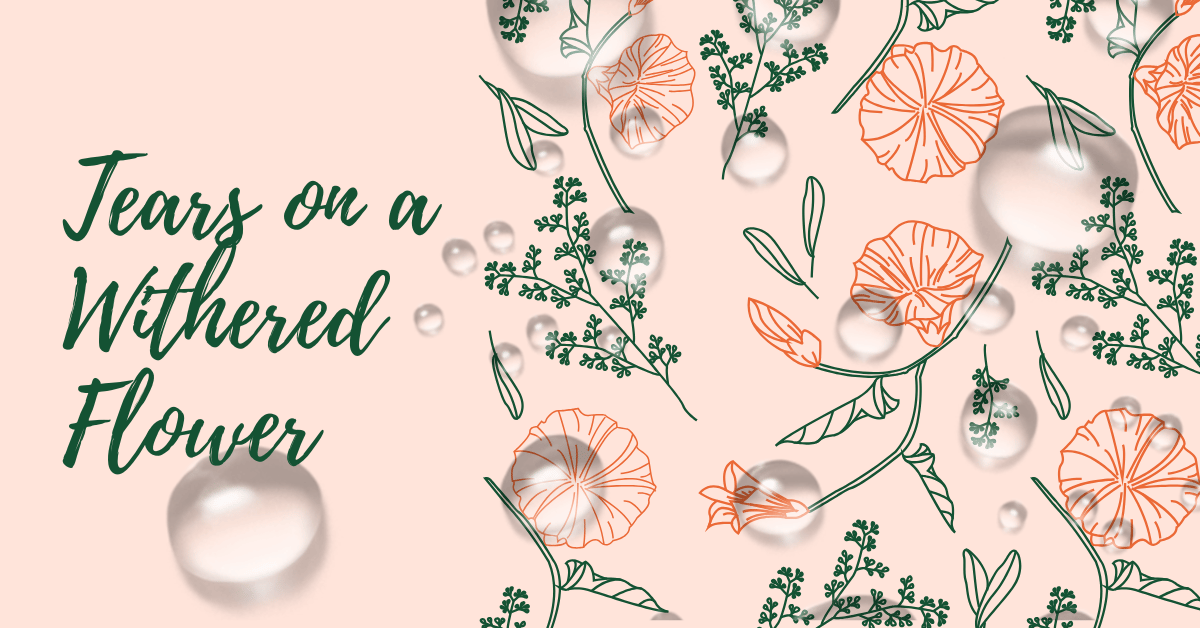The phrase “tears on a withered flower” evokes a striking image: frailty touched by grief, something once alive now tinged by sorrow. At first glance, it reads like a line from a forgotten poem. But beneath its poetic elegance lies a deeper emotional and philosophical resonance. This phrase speaks to impermanence, the human tendency to mourn too late, and the haunting beauty of things past their prime. In a time where feelings are often buried beneath speed and efficiency, “tears on a withered flower” offers a moment of stillness—and reflection.
In this article, we explore the origins, symbolic weight, and contemporary relevance of this metaphor across literature, psychology, visual art, and everyday life. We unpack how it speaks to modern emotional landscapes, both personal and collective.
The Power of Metaphor in Human Expression
Humans have always used metaphor to communicate emotions that otherwise resist simple explanation. When we say “tears on a withered flower,” we are not describing a literal act. We are giving form to complex emotional states—regret, nostalgia, futility, and the ache of watching something beautiful fade. This metaphor contains layers, much like the dried petals it evokes.
It is about:
- Mourning what has already faded
- Expressing love when it may no longer be received
- The quiet devastation of belated tenderness
Historical Uses of Floral Symbolism
Flowers have long been a stand-in for life’s transient beauty. From Ancient Egypt to Victorian England, flowers were used in ritual, art, and coded communication.
Withered flowers, specifically, have come to symbolize:
- Decay: The inevitable decline after bloom
- Endings: The final stage in a lifecycle
- Memory: Preserved beauty that no longer lives
Tears, when paired with this imagery, shift the narrative from natural decay to emotional engagement. They suggest that the withering flower is not merely an object, but one that matters. Someone is mourning it. Someone cared—perhaps too late.
Table: Symbolic Interpretations of “Tears on a Withered Flower”
| Symbol | Traditional Meaning | Implication in the Phrase |
|---|---|---|
| Tears | Grief, release, empathy | Emotional weight, often retrospective |
| Withered Flower | Lost beauty, past vitality | Representation of a missed or fading moment |
| Combination | Delayed emotion, regret, bittersweet memory | Tension between love and loss |
Literature and the Echo of Withering
Writers have long relied on floral metaphors to discuss time, aging, and sorrow. In Shakespeare’s Sonnet 18, he writes of summer’s lease having “all too short a date.” Keats, Dickinson, and Plath used similar botanical language to paint pictures of inner despair and fleeting joy.
But “tears on a withered flower” belongs less to the romantic flourish of fresh roses and more to the tragic poetry of aftermath. It is the scene after the drama. It suggests a character who realizes too late what has been lost. It is the anti-epiphany: a lesson learned in the stillness after decline.
In contemporary literature, this phrase often appears in:
- Post-romantic reflections
- Grief memoirs
- War poetry
- Stories of estranged relationships or dying traditions
Visual Arts: Rendering the Withered Bloom
In painting and photography, flowers are often used to contrast ephemeral beauty with lasting form. A photograph of a dried bouquet might carry more emotional weight than one of a fresh garden because it suggests narrative: time has passed, and someone chose to hold on.
Contemporary artists use the imagery of wilted flowers to explore themes of:
- Environmental decay
- Personal loss
- Femininity and aging
- Unspoken or expired love
Adding tears—either as literal drops or implied through lighting and tone—shifts these works from symbolic to visceral. It invites viewers not just to observe decay but to feel it.
Psychology of Belated Grief
From a psychological standpoint, “tears on a withered flower” speaks to a well-documented phenomenon: delayed emotional processing. People often suppress emotions in real-time, only to have them resurface later—sometimes when it’s too late to act.
This metaphor captures:
- Regret: Wishing you had said something while there was still time
- Guilt: Feeling complicit in someone or something’s decline
- Nostalgia: A yearning for what once was, even if it was imperfect
It also mirrors a common trauma pattern—emotion postponed until it becomes safe to feel. The flower withers in silence, and the tears come later, when vulnerability no longer threatens stability.
Table: Emotional States Evoked by the Metaphor
| Emotion | Description | Relation to the Phrase |
|---|---|---|
| Regret | Realizing a missed opportunity | The flower died without water, now tears fall |
| Longing | Yearning for the past | Mourning beauty that can’t return |
| Compassion | Deep empathy for loss | Even in decay, the flower is honored |
| Sadness | Passive melancholy | Sits quietly, watching the inevitable unfold |
| Closure | Letting go through mourning | Tears signal the end of emotional suppression |
Contemporary Relevance: Social and Global Readings
“Tears on a withered flower” has broad utility in describing not just personal emotion, but collective experiences. In a post-pandemic world, in the age of climate anxiety and cultural erasure, the metaphor resonates deeply.
Climate Crisis
The image of a withered flower—once vibrant and natural—dying under human watch speaks to the mourning of Earth’s fragility. The tears come too late, when ecosystems have already failed.
Cultural Loss
Languages dying, traditions fading, communities dispersed—these are withered flowers of civilization. Activists and archivists often operate in mourning, trying to preserve memory amid decay.
Mental Health
The phrase also encapsulates the inner terrain of burnout. People often ignore emotional needs until collapse, then grieve the self they failed to nurture.
In Music and Pop Culture
Lyrics often invoke similar imagery. While the exact phrase may not appear verbatim in many mainstream songs, the sentiment is universal. Think of:
- Love songs where the relationship died long before the lovers noticed
- Breakup albums reflecting on things that could’ve been said
- Indie bands using floral imagery to symbolize emotional ruin
Visual albums, too—from Beyoncé’s Lemonade to Mitski’s melancholic aesthetics—often show blooming beauty juxtaposed with decay, capturing the emotional DNA of this metaphor.
Personal Narratives and the Everyday Poetics
Even outside of the arts, “tears on a withered flower” happens every day.
- A parent realizing they missed their child’s best years
- An apology made after the damage is done
- Visiting a loved one’s grave with words never said in life
- Looking at old photos of someone you let slip away
The universality of these moments means the metaphor has real-world application far beyond the poetic. It becomes a language for grief, accessible to anyone who has ever mourned too late.
The Beauty in the Withered
And yet, the metaphor is not entirely tragic. There is strange beauty in the act of crying over what’s gone. It means you felt something. You loved, you noticed, even if late. There’s dignity in belated emotion—it validates the lost thing’s worth.
In Zen philosophy, the impermanence of all things is not a tragedy but a truth to embrace. A withered flower is not ugly—it’s simply finished blooming. Tears do not change this, but they honor it.
Table: Philosophical Interpretations
| Philosophy | Interpretation | Relevance to the Phrase |
|---|---|---|
| Stoicism | Accept decay, mourn briefly, move forward | Tears may reflect weakness unless disciplined |
| Buddhism | All things are impermanent | Tears are part of acceptance, not resistance |
| Existentialism | Meaning is created through action | The tears give meaning to the flower’s life |
| Romanticism | Emotion validates experience | Beauty and pain are inseparable, as reflected here |
How the Phrase Inspires Creative Work
Writers, musicians, and artists often use “tears on a withered flower” as a starting point for creation. It offers:
- A visual image
- An emotional premise
- A built-in narrative arc
Whether for a poem, a film scene, or a piece of installation art, the phrase invites creators to explore contrasts: life/death, presence/absence, love/apathy.
Examples of creative prompts:
- Write a letter to a person who’s already left
- Photograph something decaying in beautiful light
- Compose a song where the chorus is regret after silence
Why This Phrase Endures
In a digital age of shortened attention spans, it’s notable when a metaphor sticks. “Tears on a withered flower” is visceral, flexible, and elegant. It survives because:
- It captures emotion without cliché
- It is specific yet universal
- It offers a moment of slow, reflective beauty
We live in a time that rushes to move on. This phrase says: pause, grieve, and honor—even if late. Even if futile.
Conclusion: Holding Space for the Withered
“Tears on a withered flower” is more than poetic imagery. It’s a reminder that even after beauty fades, emotion remains. That recognition may not reverse the decay, but it adds meaning to the memory. In this way, the flower is not forgotten, and neither is what it once represented.
In mourning, we find meaning. In withering, we find truth. In tears, we find ourselves—finally honest enough to feel what we once denied.
FAQs
FAQs
1. What does the phrase “tears on a withered flower” mean?
It symbolizes belated emotion, such as regret, mourning, or sorrow expressed too late—after something beautiful has already faded or been lost.
2. Is “tears on a withered flower” used literally or metaphorically?
It is primarily metaphorical, representing deep emotional states like nostalgia, regret, missed opportunities, or emotional detachment turned into late realization.
3. In what types of creative works is this phrase most commonly explored?
This metaphor often appears in poetry, visual art, photography, music lyrics, and emotionally driven film or theatre, especially in scenes reflecting personal or relational loss.
4. Can this metaphor be applied to modern-day issues?
Yes. It applies to emotional burnout, climate grief, cultural loss, and post-relationship reflection—where action or emotion is delayed until after irreversible change.
5. Why does this phrase resonate so deeply across audiences?
Because it taps into a universal experience: the pain of recognizing value only in hindsight. Everyone, at some point, has mourned something too late.











